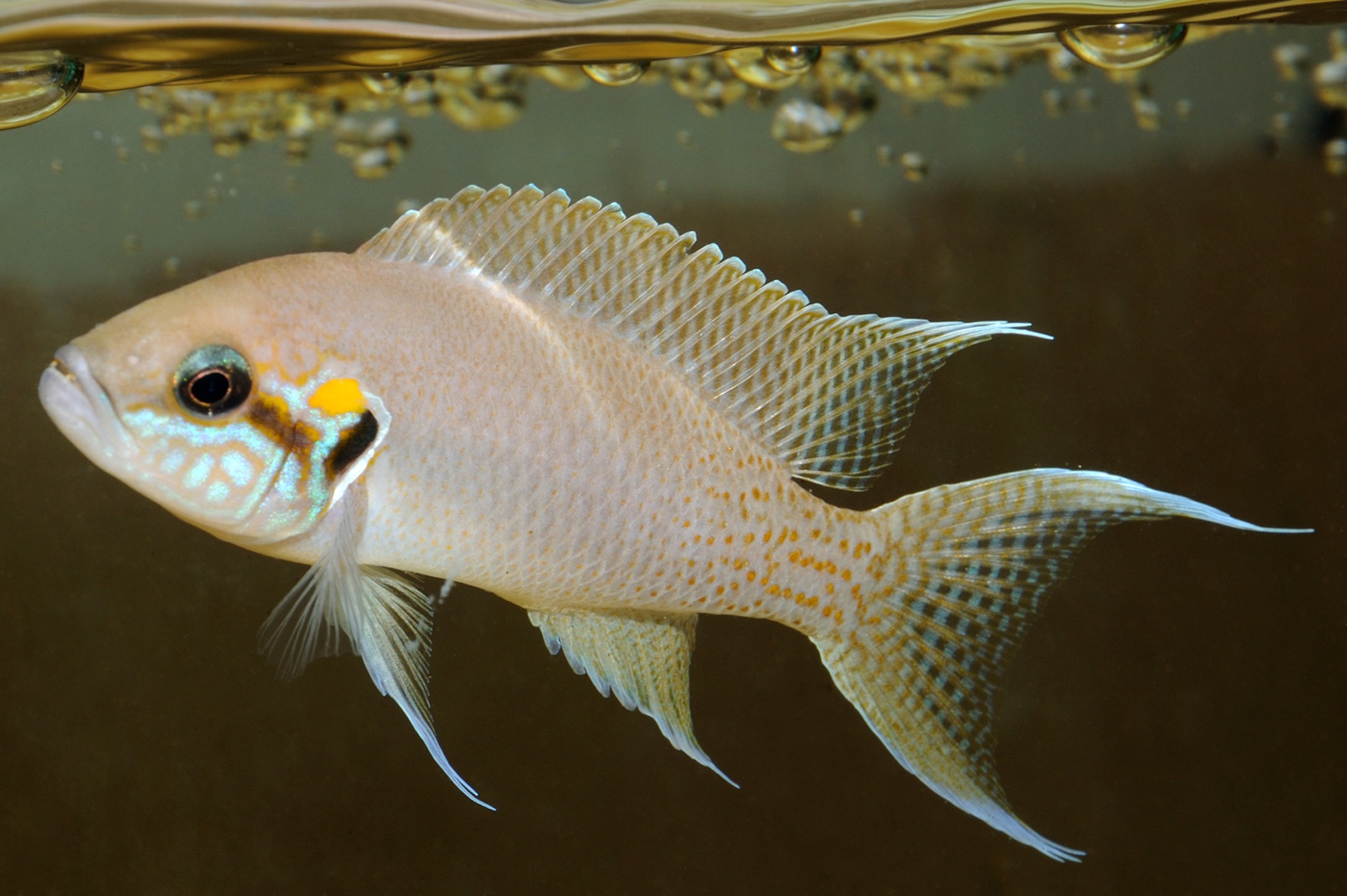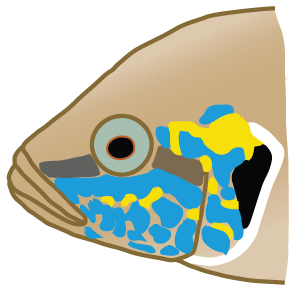What prevents animals from lying to each other? Can cheats ever prosper? A study published in Evolution Letters has provided new insight into the evolution of honest signals in cooperative Princess of Burundi cichlid fish, demonstrating that the reliability of communication between individuals is maintained by social policing. We asked Hugo Gante, a researcher at the University of Basel and co-author of the paper, to tell us more about the feisty fish he studies, and why these new findings are so interesting.

EL: Your new study investigates how the Princess of Burundi cichlid fish uses the striking colour patterns on its face to communicate its intent to fight with other fish of the same species. Conspicuous, colourful patterns like these are more typically associated with mating displays and attractiveness. Why did you think these facial patterns might be of particular importance to how the fish signal their aggressiveness?
HG: Studies on conspicuous colour patterns that differ between males and females, a condition known as sexual dichromatism, clearly dominate the literature on colour pattern evolution. In the case of sexual differences in coloration, the colourful sex is frequently the male, and research has shown that the need for males to display and attract females has lead to the evolution of extravagant coloration. Because females invest a substantial amount of resources in egg production, they want to make sure the male is of good enough quality, and we now think females use male colouration as a reliable indicator of their overall condition. In other words, males are communicating their intrinsic quality to females using colour signals.
Conversely, in the particular species we have studied, males and females look absolutely alike, a condition that is known as sexual monochromatism. The reasons for the evolution of a colour pattern that is the same in females and males must be different from those when the sexes are different. In particular, it suggests that both sexes (not just one) are communicating some information, and that information must be similar in content. We know from their biology that both male and female Princess of Burundi cichlids are very territorial and both invest in raising their young. In fact, they live in family groups that together defend their territories in the rocky shores of Lake Tanganyika against intruders. Therefore, communication during aggressive interactions was an obvious context for us to test a function of this facial colour pattern, and it turned out to be the case.
EL: You found that a fish’s face pattern changes depending on whether they win or lose a fight. How does this change happen and what does it tell us about how these fish signal their intentions to those around them?
HG: This facial mask is composed of several more or less discrete elements – blue, yellow, black and white patches. We decided to individually characterise each one of them, and we found that their physical properties and arrangement make this pattern very conspicuous to other fish. It is like the colourful masks used by humans in the Mexican free wrestling Lucha Libre.

In the case of the fish, besides the high conspicuousness of the facial pattern, we found that the intensity of the black horizontal stripe depends on whether a fish switches to a dominant or subordinate behaviour, while all the other colour patches remain relatively stable. It is important that such colour change happens fast, if you want to signal to your opponent that you’re no longer a threat before things get to a point of no return. It’s like waving the white flag. This fast change happens in a few seconds and is mediated by physiological colour changes within the black pigment cells, called melanophores. Essentially the black pigment, melanin, is transported within the melanophore to create a dark or pale aspect, depending on whether it is dispersed or aggregated, respectively. In the heat of the fight you can literally see the horizontal facial stripe change its intensity before your eyes, such that the black stripe fades and becomes light grey. In the same way the horizontal stripe pales, this state can be reversed and the stripe can become darker again in a matter of a few seconds. It is a very dynamic process. The fact that intensity of the stripe is so labile already hints at how it functions as a signal of motivation or aggressive state.

EL: Does the ‘baseline’ (e.g. pre-fight) intensity of the facial stripe vary across different fish, and is this linked to any other physical characteristics?
HG: Very small individuals do not have a facial mask. It eventually develops when the fish reach about 2–3 cm in length and once they have it, they keep it. There is always some level of individual variation associated with any trait, but the baseline intensity of the facial stripe tends to be darker, rather than paler. When a fight starts they can signal momentarily to an opponent until peace is re-established. This said, we don’t know yet how aggression and dominance is translated into colour change. That is one of our next questions, but it is possible that hormones mediate this information transfer.
EL: You also conducted an experiment where you artificially altered the intensity of the facial stripe on some fish. How did you do this and what more did it reveal about the function of the stripe as a signal to other fish?
HG: In this study we wanted to more generally address how communication can be honest. Why would animals provide honest information about their quality, condition, and intentions, if they could signal unreliably and profit from it? This question has puzzled researchers for decades and still does to some extent. Theoreticians seem to have reached an agreement that costs are responsible for maintaining honest communication, but the exact source and type of costs still remain elusive. While empiricists have tried to gather experimental evidence to support different alternatives, it is also unclear whether costs have been really measured.
We tried to address this issue by providing a framework to guide empiricists studying colour signals. First we characterise the colour pattern, then determine its function, and finally identify the source of the costs of honesty. To understand what kind of costs could be guaranteeing communication reliability, it is essential to manipulate the signal of individuals that could gain from providing inaccurate information. So essentially, we force individuals to lie by sending an inaccurate signal, and ask whether receivers of that signal can detect it. We expect that if reliability is maintained through viability and fecundity, as would likely be the case for males displaying their colours to attract females, this happens too far into the future for liar detection to evolve. Costs of honesty must therefore have a physiological basis. Conversely, liar detection is predicted to evolve for signals of labile information, such as motivation, in which case social policing can act instantaneously and impose costs on liars.
We manipulated the horizontal stripe and introduced the fish into a new tank with a mirror, where they saw their reflection as if it is the owner of a territory. We either artificially darkened the stripe by applying waterproof liquid eyeliner, or we artificially paled the stripe with a powder normally used to stop wounds in fish. In this way, we created bluffers that signalled high aggression and fighting motivation, or Trojans (in reference to the Trojan Horse) that would pretend they’re not a threat and use that as a subterfuge to strike without notice.

What we found is that both types of manipulated fish received more aggression, and faster, than controls, indicating that Princess cichlids can identify liars and punish them. Our findings support the hypothesis that social selection through receiver retaliation maintains reliable signalling of a labile state. This is important because it was not clear whether signals that are physiologically cheap to produce could be honest, and we have shown that social policing is an effective way of guaranteeing that.
EL: How do we know that these fish see signals such as colour and pattern in the same way we do?
HG: For all we know, Princess cichlids don’t see colours as we do, but it is fascinating, if not tricky to imagine how they see them. Let’s start with human colour vision. In our retina there are cells responsible for colour vision (the cones), which have three molecules (the opsins) that are most sensitive to three different colours (blue, green and red). Actually they are sensitive to different wavelengths of light and the brain eventually translates that into colours. People with red-green colour blindness have difficulty distinguishing between reds, greens, browns and oranges because of shifted opsin sensitivity (http://www.colourblindawareness.org/). So the same wavelengths are seen differently by different people depending on their opsin set. Putting it in different terms, colours are an individual perception, a brain construct, and each one of us sees them slightly differently (in general, men tend to do poorer in colour discrimination than women).
What we know about colour vision in these fish is that they are most likely trichromats like us, the exquisite aspect being that they are sensitive to ultraviolet and not very sensitive to reds. Therefore, to be able to say something about how the fish see colours we modelled their vision taking into account several things like cone types, opsin sensitivities, ambient light underwater and so forth. For instance, if you’re a diver, you know that reds become greyish the deeper you go because this light wavelength becomes attenuated underwater. Even if you don’t dive you must have experienced the effect that artificial light has on colours and how we sometimes have difficult telling which colour it is. We could determine that the facial pattern we studied is rather conspicuous to the fish, possibly like it is to us, even if they perceive the colours somewhat differently. Using this visual modelling approach we also determined that Princess of Burundi cichlids perceive changes in the intensity of the horizontal stripe, which we independently confirmed in our manipulations.
EL: How aggressive are these fish under normal circumstances? Do they fight frequently in the wild and how important is this to other aspects of their life?
HG: For a fish named Princess they are quite feisty. Anyone who has kept them as pets would confirm they can take over a large aquarium for themselves. They will not hesitate to attack an intruder to their territory, especially conspecifics. The larger fish in a family will also chase away potential predators to protect its younger members, as long as the predator is not so large as to endanger them. Unfortunately we do not know how frequently they openly fight in nature. We do know they are able to individually recognise family members and even neighbours from adjacent territories, who are tolerated if they do not pose a threat. Therefore, aggression is not indiscriminate but it can escalate very fast and hence the signalling of intent to fight can be important in preventing unnecessary injury.
EL: A key finding of your study is that these cichlids can detect and punish liars in the population, almost like their own version of a neighbourhood watch! How effective is this policing likely to be – is it ever possible for cheats to prosper?
HG: This is perhaps the single most important piece of information we found in our study. It means that even signals that are cheap to produce and carry little or no physiological costs can be honest as long as there is a potential social cost to liars. This does not mean that signalling has to be reliable at all times, but it could be rather dangerous for a fish to be caught lying. From our data it seems that bluffers would have a harder time to get by than Trojans, which is concordant with previous mathematical simulations. Hence we cannot exclude that this signalling system can be replaced by a non-signalling system driven by Trojans. We have yet to test the consequences of lying when there are by-standers, but if I was to speculate, I would say that this would only make social selection a more efficient mechanism in maintaining signalling honesty. Cichlids are known to be extremely good at extracting social information from other individuals they interact with. When you consider that these fish live in neighbourhoods, populated by both family members and adjacent families, being caught lying and getting their reputation destroyed could have dire consequences.
To find out more, read the Hugo’s study, now freely available to read and download from Evolution Letters: http://onlinelibrary.wiley.com/doi/10.1002/evl3.24/full

